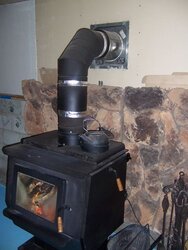O
oldspark
Guest
I have done a smoke test on the stove and stove pipe about a half a dozen times or so and have never found any leaks but today with the high winds out of the south I tried it again and guess what, I have leaks all over this pipe and this is the heat fab 22 gauge welded seam super duper pipe. One of the leaks is my fault and one is where it goes into the pipe for the chimney support. I now think I just did the smoke test on the stove pipe with the old set up and not this one as I am getting old and forgetful. Not sure if I will get the chance to fix it before my work trip next week or not as I had to order a new piece of pipe. Sorry for all the time I wasted of yours :red: , not sure if this will fix everthing but it wont hurt, I thought leaks in the stove pipe lowered the flue temps.




